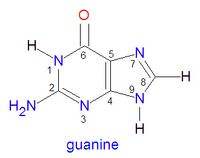Guanine: Difference between revisions
Jump to navigation
Jump to search

imported>David E. Volk No edit summary |
imported>David E. Volk No edit summary |
||
| Line 16: | Line 16: | ||
}} | }} | ||
'''Guanine''' is a natural biomolecule used as one of the | '''Guanine''' is a natural biomolecule used as one of the five bases in RNA and DNA. It is incorporated into these nucleic acids in the form of [[guanosine]], a chemical compound formed by the combination of guanine and a ribose sugar. Guanine is also naturally present in phosphorylated forms of [[guanosine]]. | ||
Revision as of 12:23, 8 April 2008
|
| |||||||
| guanine | |||||||
| |||||||
| Uses: | |||||||
| Properties: | DNA/RNA base | ||||||
| Hazards: | |||||||
| |||||||
Guanine is a natural biomolecule used as one of the five bases in RNA and DNA. It is incorporated into these nucleic acids in the form of guanosine, a chemical compound formed by the combination of guanine and a ribose sugar. Guanine is also naturally present in phosphorylated forms of guanosine.
